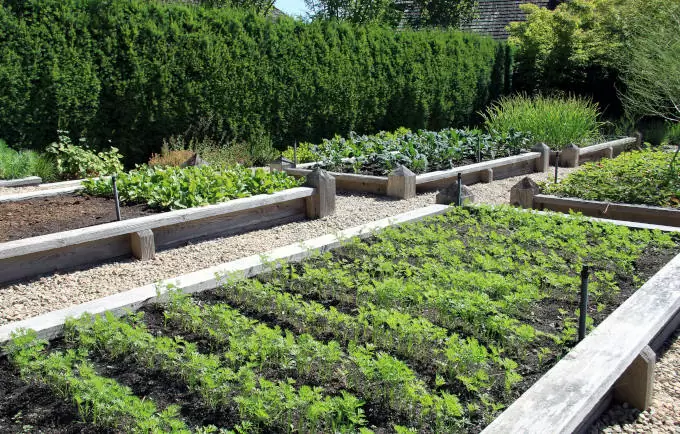
Do you have raised beds in your garden? If you don’t, you may be missing a trick. As the name suggests, raised beds involve growing plants in an enclosed area of soil and/or compost that’s higher than the rest of the garden.
There are lots of different materials that can be used including bricks or stone, concrete and even metal. The most popular option involves the use of hardwood or softwood sleepers. At the Balcombe Estate Sawmill, we supply locally grown timber sleepers (also known as railway sleepers) that are perfect for the job. Choose from new hardwood (oak) or softwood (spruce or pine) beams supplied in 2.4 metre lengths. Contact us for details and a quote.
What are the benefits of raised beds?
Raised beds can make for an eye-catching garden feature, breaking the monotony of a single level and adding a fresh dimension. Raising even a small section of your garden will provide more visual interest and a touch of professional design to your outdoor space.
In addition, introducing raised beds into your garden also has many practical gardening benefits:
- Grow a wider variety of plants. Having raised beds allows you to use different soil to the rest of the garden. If your garden soil is alkaline, use raised beds with ericaceous compost to grow rhododendrons or hydrangeas, blueberries and raspberries.
- Benefit from a longer growing season. The soil in a raised bed warms faster in the spring, meaning you can plant earlier and enjoy a longer season. Add a cover and the soil will warm up even faster, meaning you can start even earlier!
- Control garden pests with ease. With raised beds, it’s so much easier to protect young plants and crops by covering with garden netting, horticultural fleece or plastic cloches – helping to keep birds, insects, rodents and slugs at bay.
- Enjoy easier garden maintenance. Once your raised beds are built and planted up, maintenance can be as easy as weeding and dressing with compost. And because the beds are raised, you don’t have to bend over as much – no back breaking work!
What can you grow in a raised bed?
The beauty of raised beds in your garden is that they can be used to grow anything you like – from alpines to perennials, herbs, soft fruit or vegetables. Many homeowners introduce raised beds as purely decorative features or centre pieces that have nothing to do with having a vegetable patch.
Others relish the idea of using some of the outdoor space as a ‘working garden’ where fruit and vegetables can be home grown with zero food miles. Growing your own is becoming an ever more popular hobby – and what you grow is only limited by your imagination, your gardening knowledge and a few practical considerations.
Good starter veg for raised beds include:
- Radishes and carrots
- French beans and runner beans
- Courgettes and pumpkins
- Chard, spinach and lettuce
If you’re new to vegetable gardening, it’s a good idea to seek advice from more experienced veg growers and ask for guidance about what’s easiest to grow and any tips and tricks they can share. Before you know it, you’ll have green fingers and fresh produce for the dinner table!
How to make a raised bed
Getting started with raised bed gardening isn’t hard to do. All you need is some timber sleepers cut to size, a spirit level and some basic tools (rubber mallet, electric drill and long screws).
- From your lawn, dig out strips of turf that are wide enough to accommodate your timbers (or alternative choice of material for the surround). Lay the timbers out in position to form a square or rectangular frame and check that they’re level. Make sure the corners are at right angles by checking the diagonals.
- Tap the timbers into place with a rubber mallet, always checking that they’re perfectly level and straight against each other. Then drill through the end timbers and all the way into the adjoining pieces and secure the frame with extra-long heavy-duty screws at the top and bottom. Repeat this on all four corners.
- Arrange the next set of timbers on top of the first level, making sure they overlap the joints below for added structural strength. Check again with a spirit level before securing the top level into place with long screws. Finally, add some extra screws drilled down through the middle of the top sleeper into the bottom sleeper.
- Fill the inside of the raised beds with a bottom layer of builder’s rubble to improve drainage, then top up with good quality topsoil and compost. For added weed protection, you may wish to line the inside of your bed with a garden membrane first. Make sure you choose one that’s water permeable, so it lets rainwater through but keeps weeds out. You’re ready to start planting.
At the Balcombe Estate Sawmill, we’ve been supplying landscaping materials to residential and commercial clients in Sussex for over 40 years. Raised beds can easily be constructed with untreated and locally sourced materials including our treated softwood sleepers, railway sleepers and prime-grade sleepers. Why not get in touch with our team today to discuss your project and obtain a competitive quote?
